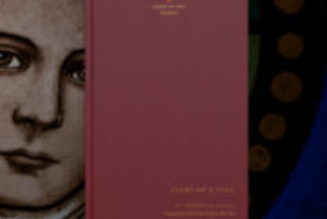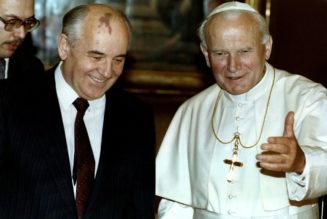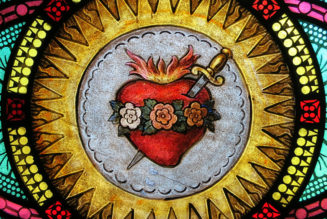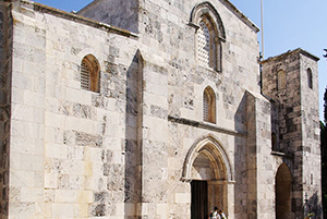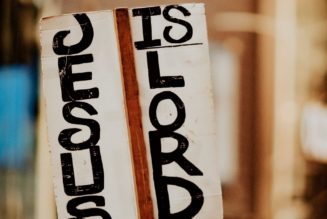Pope St. John XXIII presiding over the opening Mass of the Second Vatican Council. Lothar Wolleh, Public domain, via Wikimedia Commons
 Sixty years ago, on Oct. 11, 1962, Pope St. John XXIII solemnly opened the Second Vatican Council. Addressing the council fathers, he said, “The major interest of the Ecumenical Council is this: that the sacred heritage of Christian truth be safeguarded and expounded with greater efficacy.” Referring to the sweeping political and economic changes that had occured in the 19th and 20th centuries, John XXIII rejoices that the Church would have the opportunity to return to the essentials of the spiritual life, particularly the instruction of the faithful. Free from “worldly fetters that trammelled her in past ages,” Holy Mother Church had a new opportunity to preach and catechize.
Sixty years ago, on Oct. 11, 1962, Pope St. John XXIII solemnly opened the Second Vatican Council. Addressing the council fathers, he said, “The major interest of the Ecumenical Council is this: that the sacred heritage of Christian truth be safeguarded and expounded with greater efficacy.” Referring to the sweeping political and economic changes that had occured in the 19th and 20th centuries, John XXIII rejoices that the Church would have the opportunity to return to the essentials of the spiritual life, particularly the instruction of the faithful. Free from “worldly fetters that trammelled her in past ages,” Holy Mother Church had a new opportunity to preach and catechize.
Further clarifying, the pope said, “What is needed, and what everyone imbued with a truly Christian, Catholic and apostolic spirit craves today, is that this doctrine shall be more widely known, more deeply understood and more penetrating in its effects on men’s moral lives.” For John XXIII, this wasn’t a matter of changing timeless truths — he insisted that it “is absolutely vital that the Church shall never for an instant lose sight of that sacred patrimony of truth inherited from the Fathers” — but rather a matter of updating the way in which these sacred, perennial and unchanging truths are set forth in Church teaching.
But such a project was far from easygoing. The night that John XXIII announced his plans to call a council, Cardinal Giovanni Battista Montini (who became Pope St. Paul VI in 1963) called a friend and commented, “This holy old boy doesn’t realize what a hornet’s nest he’s stirring up!” The specters of simplistic divides according to narrow political terms — as reported in the American press and elsewhere — between well-meaning liberals deemed morally good and corrupt conservatives defending a dysfunctional status quo haunt the Catholic faithful to the present day. A hornet’s nest indeed!
To respond to these and other phantoms, some Catholic intellectuals have begun to argue that the council was hijacked. These thinkers are looking for a way to reconcile the dolorous realities of early 20th-century history and John XXIII’s noble intentions with results of the council such as the Church’s teaching on religious liberty, ecumenical overtures or adaptations to the liturgy — results with which they do not themselves agree.
Others will say the documents of Vatican II — that is, the actual teaching of the council — are sound. However, the application of the teaching by many was ill-considered, even heretical. This argument makes an attempt to remain faithful to the substance of conciliar teaching while offering an explanation for what many have suffered during the post-conciliar crisis, including the destabilizing effects of swift (and often ill-explained) changes to the liturgy, religious life and many other facets of life in the Church.
Still others will argue that the destabilization of the post-conciliar period has continued, in large part, because the spirit of the council was not actually adopted or followed to its fullest conclusion. Often, proponents of this view will argue that the Church needs more radical changes, like ending clerical celibacy, admitting women to holy orders, redefining our God-given human sexuality, and more.
I think one of the keys to focusing on our attempts to interpret the council is to underscore that the council was necessary. Looking back on Vatican II today, it’s easy to get caught up in our experience of the council, either by having lived through the marked changes to ecclesial life of Vatican II or growing up in a Church that has embraced and implemented them.
But such a view has a great risk. As one Catholic intellectual has warned, when looking back at Vatican II, it’s easy for the faithful to fall right into a very simple logical fallacy: post hoc ergo propter hoc. According to this fallacious reasoning, since Y followed X, X therefore caused Y. To conclude that the way things are now in the Church — for good or for ill — is because of Vatican II is simply reductionist. After all, correlation does not prove causality.
To emphasize the necessity of the council means that we would embrace the council as the only way. Guided by the Holy Spirit, the Church needed the determinations of the Second Vatican Council to be a guiding light for us, as we began to navigate the dark and stormy seas of post-modernity.
Embracing the necessity of the council means that we can take seriously its causes and come to know the needs of that moment in Church history more completely. In George Weigel’s new book on Vatican II, “To Sanctify the World” (Basic Books, $32), he attempts to do exactly that. Every faithful Catholic interested in unpacking Vatican II should read the documents of the council. This is the most important work: reading, reflecting and praying over these texts as interpreted by the Church. But the documents of the council need a framework. And Mr. Weigel’s suggestion to take seriously the twin currents of thought and history that prompted John XXIII to act 60 years ago is a good one.
Father Patrick Briscoe, OP, is editor of Our Sunday Visitor.
Join Our Telegram Group : Salvation & Prosperity



